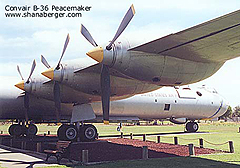|
||||
|
Convair B-36 Peacemaker
|
|
In
the early Cold War, the Convair B-36 was the symbol of
American ability to deliver nuclear weapons anywhere in the
world. Belief in it's deterrent ability lead to the nickname Peacemaker.
The design of the B-36 began in 1941 when the U.S. contemplated the possibility that Nazi Germany would control all of Europe and that the U.S. would only be able to strike Germany from bases in the U.S. The demand for range dictated the new bomber's size. In late 1941, the U.S. entry into World War II shifted priority to aircraft with more immediate application. It wasn't until 1946 that the first prototype flew. The first B-36s were delivered to the U.S. Air Force in 1948. The B-36 added jet engines to increase take-off weight and speed over target and was also used in a reconnaissance role (RB-36). Other roles included experiments in carrying it's own fighter escort or reconnaissance aircraft to extend it's range and carrying an active atomic reactor. The last B-36s were retired in 1959, replaced by the Boeing B-52. |
|||||||||||||
| Specifications (B-36J) |
Designations |
|||||||||||||
|
|
|
|||||||||||||
|
|
|||||||||||||
|
Related Pages |
Related Websites |
|||||||||||||
|
|
|||||||||||||
|
Stuff You Can Buy |
||||||||||||||
|
||||||||||||||
|
|
|
||||||||||||||||||||||||||||||||||||||||||







